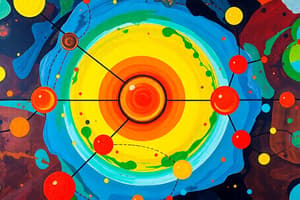Podcast
Questions and Answers
What are the four most common chemical elements in living organisms?
What are the four most common chemical elements in living organisms?
Carbon, Nitrogen, Oxygen, Hydrogen
Describe the structure of an atom with respect to the arrangement of protons, neutrons, and electrons.
Describe the structure of an atom with respect to the arrangement of protons, neutrons, and electrons.
An atom's center is the nucleus. Protons revolve around the nucleus, electrons are on the outer shells. Electrons are negative, neutrons are neutral, and protons are positive.
Explain the relationship between electron orbitals and energy shells.
Explain the relationship between electron orbitals and energy shells.
The first shell has the lowest energy, the second shell has higher energy, and the third is the highest. There are 2 electrons in the inner shell, 6 in the second, and 8 in the last.
Predict the relative amount of potential energy in electrons that occupy orbitals in different energy shells.
Predict the relative amount of potential energy in electrons that occupy orbitals in different energy shells.
Explain the importance of valence electrons and the formation of chemical bonds.
Explain the importance of valence electrons and the formation of chemical bonds.
Explain how covalent bonds, ionic bonds, and hydrogen bonds differ from one another.
Explain how covalent bonds, ionic bonds, and hydrogen bonds differ from one another.
Explain the difference between polar and nonpolar covalent bonds.
Explain the difference between polar and nonpolar covalent bonds.
Describe how a hydrogen bond forms.
Describe how a hydrogen bond forms.
List similarities and differences between hydrogen bonds and ionic bonds.
List similarities and differences between hydrogen bonds and ionic bonds.
Explain how polar covalent bonds and hydrogen bonds contribute to the special properties of water.
Explain how polar covalent bonds and hydrogen bonds contribute to the special properties of water.
Compare hydrophilic and hydrophobic.
Compare hydrophilic and hydrophobic.
Explain the relationships among hydrogen ion concentration, acidity, and the pH scale.
Explain the relationships among hydrogen ion concentration, acidity, and the pH scale.
Flashcards are hidden until you start studying
Study Notes
Common Chemical Elements
- Four most common elements in living organisms: Carbon, Nitrogen, Oxygen, Hydrogen.
Structure of an Atom
- Atom's nucleus contains protons and neutrons.
- Protons are positively charged, neutrons have no charge, and electrons are negatively charged, orbiting around the nucleus.
- Electrons reside in outer shells, while protons and neutrons are in the nucleus.
Electron Orbitals and Energy Shells
- Energy shells correspond to distance from the nucleus; the first shell is lowest energy, and subsequent shells increase in energy.
- First shell holds a maximum of 2 electrons, the second holds 6, and the third holds 8.
Potential Energy in Electrons
- Electrons closest to the nucleus (first shell) possess the least potential energy; those in outer shells (second and third) have progressively more.
Valence Electrons and Chemical Bonds
- Atoms seek stability by filling their outer electron shell, leading to electron sharing or transfer to form bonds with other elements.
Types of Bonds
- Ionic Bonds: Formed by the attraction between oppositely charged ions (cations and anions).
- Covalent Bonds: Formed by sharing of electron pairs between atoms; most secure bond type.
- Hydrogen Bonds: Weaker attractions between a hydrogen atom and an electronegative atom, important for molecular interactions.
Polar vs. Nonpolar Covalent Bonds
- Nonpolar Covalent Bonds: Electrons are shared equally between atoms, typically hydrophobic.
- Polar Covalent Bonds: Electrons are shared unequally, creating a dipole; one atom has a partial negative charge and the other a partial positive charge.
Formation of Hydrogen Bonds
- Hydrogen bonds are established between polar molecules due to partial charges; represented by dotted lines.
- They involve existing covalent bonds and create temporary attractions.
Similarities and Differences: Hydrogen Bonds vs. Ionic Bonds
- Both bond types are charge-based; however, ionic bonds have full charges and are strong unless in water, while hydrogen bonds have partial charges and are relatively weak, forming between molecules.
Water's Unique Properties: Covalent and Hydrogen Bonds
- Water (H2O) has a polar structure due to uneven electron sharing, with oxygen partially negative and hydrogen partially positive.
- Hydrogen bonds form between water molecules and other electronegative atoms (N, O, F), contributing to water's unique properties.
Hydrophilic vs. Hydrophobic
- Hydrophilic substances easily dissolve in water, while hydrophobic substances do not mix well with water.
pH Scale and Acidity
- pH scale ranges from 1 (acidic) to 14 (basic), with 7 being neutral.
- Acidic solutions have higher hydrogen ion concentration and lower pH values (1-6.999), while basic solutions have lower hydrogen ion concentration and higher pH values (8-14).
- pH is determined on a logarithmic scale, reflecting a tenfold change with each unit.
Studying That Suits You
Use AI to generate personalized quizzes and flashcards to suit your learning preferences.




